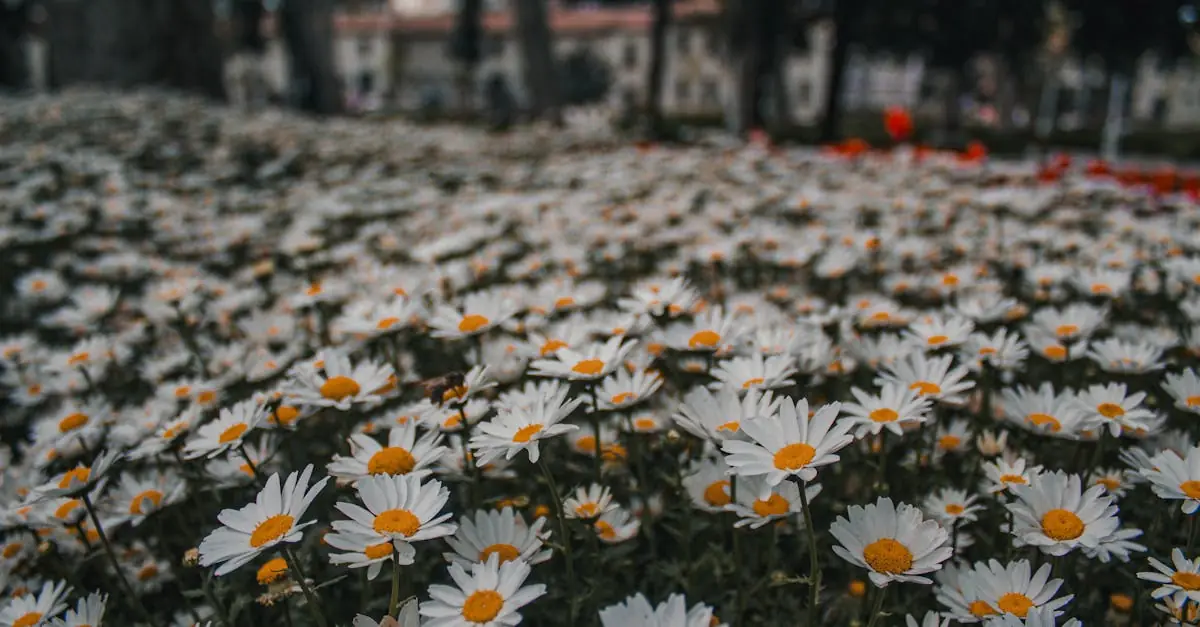Imagine stepping into a vibrant world where colors dance and fragrances flirt with your senses. Flower gardening isn’t just a hobby; it’s a delightful escape from the daily grind. Whether you’re a seasoned green thumb or a curious newbie, cultivating a garden bursting with blooms can transform any ordinary space into a breathtaking oasis.
Not only does flower gardening brighten up your surroundings, but it also offers a chance to unleash your creativity. From selecting the perfect palette to arranging blooms like a floral Picasso, the possibilities are endless. Plus, who wouldn’t want to impress their neighbors with a garden that says, “I’ve got my life together”? So grab your trowel and let’s dig into the enchanting world of flower gardening, where every petal tells a story and every bloom is a step closer to paradise.
Table of Contents
ToggleWhat Is Flower Gardening?
Flower gardening involves cultivating various flowering plants for aesthetic and sensory enjoyment. This gardening practice transforms outdoor and indoor spaces into vibrant displays of color and fragrance. Many people engage in flower gardening for its therapeutic benefits, creating a serene environment that reduces stress.
Gardening includes selecting suitable plants based on local climate, soil conditions, and maintenance requirements. Annuals, perennials, and biennials each contribute unique characteristics to a garden. Annuals bloom brightly for one growing season, while perennials return year after year, establishing a lasting garden presence. Biennials complete their life cycle in two years, adding diversity to the floral arrangement.
Another important aspect of flower gardening is understanding plant placement. Grouping flowers with similar light and water needs ensures healthy growth. Additionally, considering seasonal blooms creates continuous visual interest throughout the year. Color combinations, textures, and heights play crucial roles in achieving a stunning landscape.
Soil preparation stands as a foundational step in flower gardening. Proper soil amendments and nutrient enhancement support robust plant development. Regular watering and weeding help maintain the garden’s health, promoting healthy flowering.
Flower gardening attracts a spectrum of enthusiasts, from beginners to seasoned gardeners. Each gardener brings their creativity, resulting in unique landscapes. Creating a flower garden offers endless possibilities for expression and enjoyment.
Benefits Of Flower Gardening
Flower gardening offers numerous benefits that enhance both mental well-being and the environment. Engaging with colorful blooms can significantly improve one’s quality of life and promote ecological balance.
Mental Health Benefits
Gardening acts as a powerful tool for mental health. It encourages mindfulness and helps individuals manage stress. Studies indicate that spending time in gardens can reduce anxiety and improve mood. The act of nurturing plants fosters a sense of responsibility and accomplishment. Social interaction often occurs in community gardens, creating connections that enhance feelings of belonging. Exposure to natural light while gardening also supports vitamin D production, further boosting happiness levels.
Environmental Impact
Flower gardening contributes positively to the environment. It promotes biodiversity by attracting pollinators such as bees and butterflies. These insects play a critical role in maintaining healthy ecosystems. Plants improve air quality by absorbing carbon dioxide and releasing oxygen. Additionally, gardens can reduce urban heat effects by providing shade. They also prevent soil erosion, as root systems stabilize the ground. Flower gardens support water conservation, especially when native plants are selected for cultivation.
Getting Started With Flower Gardening
Flower gardening requires careful planning and consideration. Several key factors contribute to a successful and vibrant garden.
Choosing The Right Location
Selecting an ideal location significantly impacts plant health. Light exposure plays a crucial role; most flowering plants thrive in full sun, receiving at least six hours of sunlight daily. Soil drainage also influences plant growth; elevated areas or sloped spots often provide better drainage than flat ground. Observe wind patterns, as strong winds can damage delicate flowers. Additionally, consider proximity to water sources for easy irrigation. Assess existing landscape features, like trees or buildings, that might create shade or block sunlight. Understanding these factors leads to discovering the perfect spot for a flourishing flower garden.
Selecting Plants For Your Garden
Choosing the right plants enhances the beauty and longevity of the garden. Climate considerations are crucial; selecting native species often ensures resilience and adaptability. Research flowering seasons; some plants bloom in spring while others flourish in summer or fall. Aim for a variety of heights, colors, and textures to create visual interest. Grouping flowers with similar water and light needs simplifies maintenance. Local nurseries often provide expert advice; they can help identify the best options for specific conditions. Exploring flower combinations can lead to stunning arrangements, resulting in a captivating, harmonious display.
Essential Tools And Supplies
Effective flower gardening requires the right tools and supplies. These essentials facilitate healthier gardens and reduce labor.
Gardening Tools You Need
Basic gardening tools simplify tasks. A trowel, for digging holes and moving soil, serves as a staple. Pruners help maintain plant health by trimming dead or overgrowth. A rake levels soil and removes debris. Gloves protect hands, making gardening safer and more comfortable. Watering cans allow precise watering, while a garden hose accommodates larger areas. Additionally, a spade assists in digging deeper holes and relocating soil effectively. Tool organizers keep equipment accessible and in good condition.
Soil And Fertilizer Considerations
Soil quality greatly influences plant growth. Conduct soil tests to determine pH levels and nutrients. Organic matter, such as compost, enriches soil structure and fertility, promoting healthier blooms. Fertilizers, including slow-release options, provide essential nutrients throughout the growing season. Focus on balanced formulations containing nitrogen, phosphorus, and potassium. Mulching helps retain moisture, regulate temperature, and suppress weeds. Regularly amending soil with organic matter fosters an ideal environment for colorful, thriving flowers.
Common Challenges In Flower Gardening
Flower gardening presents unique challenges that can hinder successful cultivation. Pests often disrupt plant health, feeding on flowers and foliage. Managing pests requires identification of specific insects and applying appropriate, environmentally friendly treatments.
Weather impacts flower gardening significantly. Extreme temperatures, whether too hot or too cold, can stress plants. Adapting gardening practices to local climate conditions enhances resilience.
Soil health matters greatly in achieving vibrant blooms. Poor drainage leads to root rot, while nutrient deficiencies stunt growth. Testing soil for pH and nutrients helps determine necessary amendments.
Competition from weeds can diminish flower garden aesthetics and health. Weeds compete for nutrients and water, thus aggressive removal and mulching are recommended strategies. Preventing weeds through regular maintenance yields better results.
Plant selection poses another challenge. Choosing flowers that thrive in a specific area’s climate and soil composition ensures optimal growth. Not all flowers perform well in every environment, so research into native varieties often proves beneficial.
Timing plays a crucial role in flower gardening success. Planting flowers at the right time maximizes blooming potential. Observing seasonal patterns ensures a continuous display of color throughout the year.
Ineffective watering practices can also lead to challenges. Overwatering or underwatering disrupts plant health and growth. Developing a consistent watering schedule tailored to plant needs results in healthier flowers.
Support structures may also be necessary for certain flowering plants. Staking tall varieties prevents breakage and promotes upright growth. Installing these structures early minimizes damage during storms or heavy rains.
Addressing these common challenges enables gardeners to cultivate beautiful, thriving flower gardens that provide enjoyment and satisfaction.
Flower gardening offers a unique blend of creativity and tranquility that enriches both personal spaces and mental well-being. By engaging in this rewarding hobby, individuals can transform their environments into stunning displays of color and fragrance while fostering a sense of accomplishment.
The therapeutic benefits of nurturing plants extend beyond aesthetics, promoting mindfulness and reducing stress. Whether one is an experienced gardener or just starting out, the journey of cultivating a flower garden provides endless opportunities for learning and growth.
Embracing the challenges and joys of flower gardening not only enhances one’s living space but also contributes positively to the environment. With each bloom, gardeners can celebrate their connection to nature and the vibrant life it brings.




